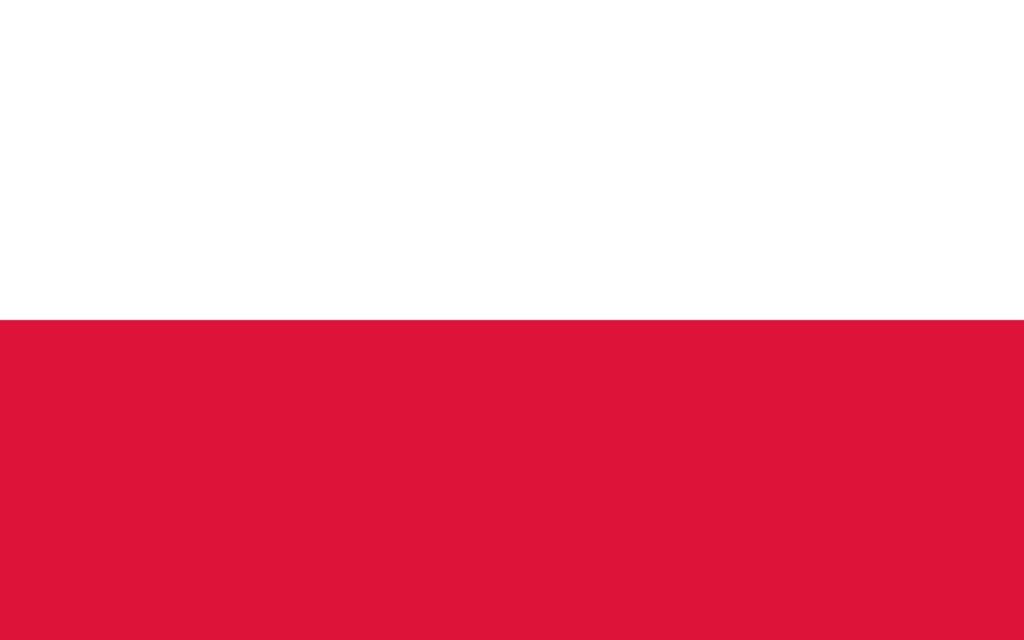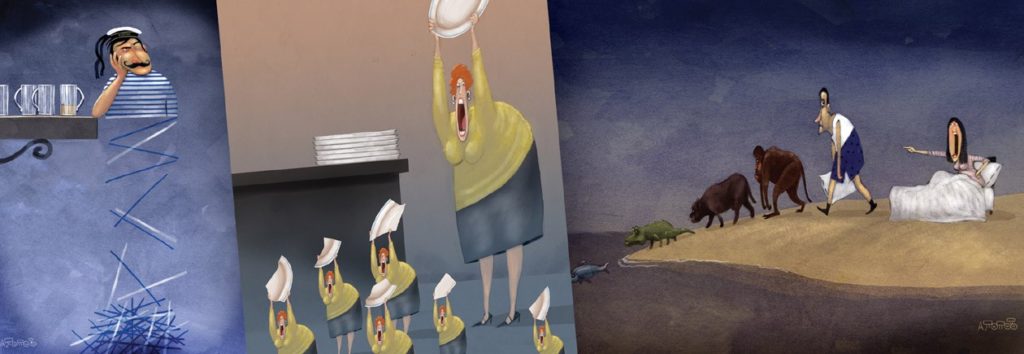An interview with Andrei Popov (Grand Prix Satyrykon 2015)
Beata Adamek, Satyrykon: Although we often joke that all great Russian or former soviet drawers are space engineers by their qualifications, let’s assume that your background is not quite typical. How is a soldier made a cartoonist?
Andrei Popov: There’s a saying that an artist is a man who still keeps child deep in himself. And so, I just returned to what my parents and my teachers from art workshops encouraged me to do in my childhood. I met a peer there, Jevgenij Muraviov, who’d mastered, inadequately to his age, the skill of drawing grotesque battle scenes or ordinary life sketches. He’d just enchanted us – the pupils and teachers with his drawings. Many years later, during my studies at Military Space Institute, I recalled them and started similar creations on my own, observing life in cadet squad in big city. The moments of drawing became my own little world in which the hardship of soldier life, need for seriousness, concentration and responsibility were all put a little aside. It was the outcome of my emotions, I commanded the crew, laughed and created absurd funny situations. Important thing was that my comrades liked it too. I realised I somehow could influence a little bit the world around me. As the time passed by, this untamed passion for ironic drawing and analytical approach to problems, resulting from my technical education, influenced the choice of my further career. “Business Petersburg” paper became my first workplace as a drawer. Although I’ve been dealing with caricature for over 15 years, I still have the sense of being at the start of my way. There’re still things I want to learn, to realise! In Russia, we’ve got the saying “He got off a ship straight into a ball”, and that’s what I like.
As for the satirical artist you seem to be exceptionally gentle. Critics, colleagues and your art lovers write of you as a romantic, a philosopher or a poet. Your cartoons are often shared on the Internet with slogan “a positive thing” from Popov. Don’t you ever get angry and feel tempted to stick the knife in a bit more?
I don’t entirely consider myself a satirist. Satire is an open kind of critique, it often contains some spicy exaggerations and majority of my work can hardly be called so. Once asked what pictures he liked painting, a great Colombian artist, Fernando Botero answered just: “beautiful”. No matter how strangely that would sound, I probably also like drawing beautiful pictures. Quite honestly, I’ve never considered what gender of art I should belong to. I just draw, with smile and ironically with very little addition of cynicism, rather with hope for surprise and amusement in my audience. I’d like to speak about something commonly understandable, eternal, and speak with language of feelings, broadening a bit the kind of funny caricature. I’d like to stress in my work clarity, expression – as it is expression that was taught to me by my first teacher at art workshop, a fantastic artist, Jakub Frumgarts. But I don’t tend to punch anybody, this niche is full of specialists commenting current events with their sharp masterpieces which are as short-lived as butterflies. But who knows? “Never say never”.
One of your recent exhibitions was called “No word”. So, is it possible to say everything without words?
I consciously restrict myself and try to work only with picture. And in result, this restriction makes me understandable in all the continents. I’d say more – a lot in peoples’ actions, everyday life, politics etc. comes down to simple and general concepts and motives. Life, death, love, greed, fear, sensitivity – all can be reflected without words, with use of associations.
You’re the winner of this year’s Satyrykon Grand Prix and at this Satyrykon edition we’ll present the exhibition of your paintings as… the best debut. “Debut” is like a wink of our eye as you’ve been drawing (and been well appreciated all over the world) for many years. What’s more, your philosophical satirical painting without words perfectly fits Satyrykon formula and we’ve had quite a few common friends. The fact is still though that you’ve taken part in Satyrykon for the first time this year. Is it really so truly strange nowadays that a Russian author would sooner send his works for competitions in China, South America or Iran rather than to Poland?
I don’t make such choice, I think it’s stupid and for majority of Russian drawers such invented problem doesn’t exist at all. I’d much rather consider the topic, the information of the quality of institution and the history of the competition than geopolitics. I feel a bit lost when the topic is not specified. Which of my work to choose? What to draw? As I’ve already mentioned, topic is one of the factors in my inspiration and political competitions aren’t my priority because I don’t perceive myself as a political cartoonist. The works of Polish colleagues are quite close to me and a lot of my friends, cartoonists from Petersburg. I can see we share the concept of good caricature and thus of basic life priorities, culture values – and politics is not capable of ruining that. I wish those bonds maintained and got even deeper.
If one can envy You anything in Petersburg, it’s your strong, befriended and enjoying themselves cartoonist fraternity. It seems that such satirists’ “clubs” are generally Russian specific, yet You are still somehow outstanding. What is the difference between satirical Petersburg and, for example, satirical Moscow?
Much true – a formidable team’s been formed in Petersburg. We don’t have any reasons for professional conflicts or quarrels. Everyone can find their place under the sun and nobody needs to get in anybody’s way. Victor Bogorad’s workshop (thanks to Victor so much!) has become a well-known place in Russia and abroad. People who love caricature meet there and share their impressions, enjoy their friends’ success, create, invent new projects and support themselves. Not surprisingly then, I’m not going to visit Legnica on my own but with a small group of my friends, cartoonists and caricature lovers from Petersburg.
We tell people apart into early birds or night owls. Looking at your drawing one might have feeling that you enjoy mornings as much as evenings. Whose idea were the good morning and good night cartoons?
We say in Russia that “Morning’s wiser than evening”. But it’s not about me. Evening time is more attractive for “thinking in” the drawing. Daily hustle and bustle comes away, and night covers all unnecessary details, the world becomes quiet and a little mystical. It makes me share my observations and feelings. I noticed that on the Internet, especially on Facebook, people wish their friends good night and good day often attaching some pictures or photos. So, with a friend of mine, Victor Bogorad, a splendid, absolutely superb Russian cartoonist and countryman, we came up with idea of complementing our almost daily wishes with sketches or ironical cartoons. These were the origins of project which now has been going on for over 2 years. I wish it would be exhibited and published some day in future. It might attract Polish publishers, cartoon lovers’ attention – We’ll be willing to cooperate.
You’ll visit Satyrykon for the first time this year. However, our common friends might have told you somewhat about Legnica. Do you have any expectations?
Of course, it’s impossible to deal with caricature on serious ground and not to know about Satyrykon and Legnica. It’s through Legnica festival and competition that I’ve heard of such names as Legus, Bogdanowicz, Chodorowski, Sliva, Crihana, Kuczyński and others. Quite honestly, my expectations have already come true: Grand Prix and individual exhibition in Legnica are great honour for me. I’m looking forward to meeting interesting people really obsessed with caricature. I’m surely curious of the town and its old history as well. Actually it’s kind of funny that Legnica used to be called Little Moscow.
I felt intrigued by one more thing in the biographical note you sent to us. Almost all the world knows Your satirical drawings, but what is this thing with clothes in-prints? Are you planning to change the profession once again? Do you like fashion at all?
Oh, it’s been really interesting and successful experience. A talented Moscow-based designer and an experimenter, Ludmila Norsoyan, has turned to me with offer of using one of my space topic related works in building her brand and elements of clothes collection. It’s really nice to touch high quality silk scarf with your drawing. It feels great when something that you’ve created doesn’t only look well in a frame but also has some practical value. We still continue our cooperation. Mark Twain once joked on fashion that “A gown makes a person beautiful. The naked ones seldom have the influence on society. Virtually none.” Fashion is experiment and experiment is what I like.
ANDREI POPOV
Painter, Cartoon Artist & Illustrator
Andrei Popov was born on 13 February 1970. He began to draw from an early age. His family military background resulted in his education at Mozhaysky Military Air Academy between 1987 and 1992. In 1995 he left the military career to become a free lance cartoon artist. His free lance career took off in 1997 when he began working with a St Petersburg newspaper „Business St Petersburg”. Over the years the artist cooperated with many newspapers and magazines, such as „Business St Petersburg”, „Journalism & Media Market”, „Izvestia-Petesburg”, „Evening St Petersburg”, „Publish”, “Psychologies”. This is just a short list of all the publications the artist was involved with. He is a member of a „Russian Caricature Club”, an international club „Cartoonion” and a project „Cartoonbank”. Throughout his career, Popovfrequently participated in numerous Russian and International exhibitions and competitions, as a participant, as well as an organiser and a judge. He received top awards for his creations in countries like Italy, Hungary, Turkey, Luxembourg, Denmark, China, Azerbaijan, Belgium and Poland. His other talents include book illustrating and creating prints for the fashion industry. In 2012 Andrei published his first album as part of the series „Gallery of Caricature Masters”. He lives and works in St Petersburg.



